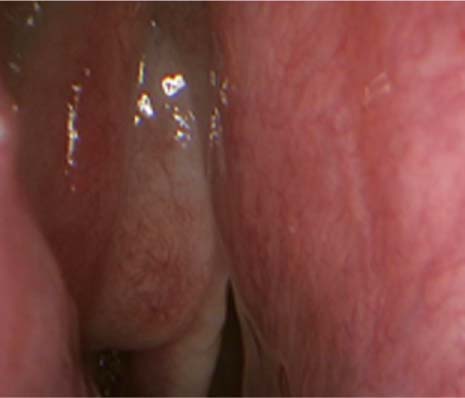46 A 54-year-old white man complains of olfac-tory loss that seemed to persist following a severe upper respiratory infection that he suffered 15 months ago. The infection has since cleared, and he reported no residual nasal obstruction, postnasal drainage, or recurrent infections. The patient denied any history of allergies or asthma. He reported a history of a broken nose and resultant deviated septum from an injury 5 years ago but no other facial trauma. He denied any history of toxin, chemical, or solvent exposure. The patient noted that on occasion he could detect an unpleasant odor that was difficult to describe, but he characterized it as rotten. It seemed to occur spontaneously, without relation to any obvious environmental stimulus, although it had diminished somewhat in frequency over the past few months. He did report that his taste perception had decreased the same time as his loss of smell, although he noted that he could clearly distinguish salty, sour, sweet, and bitter taste sensations. The patient further reported an unremarkable medical history, was on no medications, and did not smoke or drink alcohol. On physical examination, anterior rhino-scopy demonstrated a patent nasal airway with mild deviation of the septum. No erythema, rhinorrhea, crusting, discharge, or nasal polyps were visible. Oral examination also showed no erythema, lesions, or excessive dryness. The tongue showed normal-appearing mucosa and papillae on the dorsal surface. The remainder of the head and neck examination was unre-markable. Olfactory testing was performed (see below) and was consistent with severe hyposmia. After application of topical anesthesia and decongestion, nasal endoscopy was performed. In both the right and left nasal passages, the middle meatus and superior meatus were clear of polyps, discharge, or signs of inflammation. No tumors or scarring were present, and the airspace surrounding the olfactory cleft was clear. 1. Dysfunction of the olfactory system may be due to a conductive or sensorineural loss. A conductive loss is due to obstruction of the airflow carrying odorant molecules to the neuroepithelium located in the olfactory cleft, which consists of the superior nasal septum, the upper aspect of the superior turbinate, and the superiorlateral nasal wall. This cleft is approximately 1 mm wide. Sensorineural losses result from dysfunction along the neural pathway from the neuroepithelium to central processing locations via the olfactory bulb. 2. Nasal or sinus pathology is the only cause of a conductive olfactory deficit and may include diseases such as sinonasal neoplasms, nasal inflammation and polypoid disease consistent with chronic sinusitis and even adenoidal hypertrophy where transport of odorant molecules to the olfac-tory cleft is decreased or absent altogether as the result of absence of nasal airflow. Nasal airflow obstruction is suggestive of a transport defect, but only around a third of patients with an obstructive loss report such symptoms, and its absence should not rule out an obstructive cause. A fluctuation in the loss of smell suggests variation with changes in nasal congestion and occurs only with an obstructive loss, commonly in patients with chronic sinus disease and nasal polyposis. Unilateral symptoms and epistaxis should raise suspicion of neoplastic disease, which only rarely manifests with isolated anosmia. Nasal endoscopy should be performed in all patients with decreased olfaction and can detect more subtle pathology, such as within the nasal vault, ostiomeatal complex, or sphenoethmoidal recess, which might not be evident on anterior rhinoscopy (Fig. 46.1). Fig. 46.1 Nasal endoscopic view of a small polyp within the right middle meatus in a 50-year-old woman complaining of olfactory loss but without a history of sinusitis, demonstrating the importance of a thorough nasal endoscopic examination. 3.
Anosmia
History
Differential Diagnosis—Key Points
![]()
Stay updated, free articles. Join our Telegram channel

Full access? Get Clinical Tree



